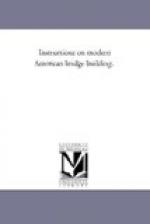=Upper Chords.= The upper chords are compressed as forcibly as the lower ones suffer tension—owing to the action and reaction of the diagonals. In this case the compression is 268800 lbs., and as 1 square inch of section will safely bear 1000 lbs., we have for the
268800 area required, ------ = 268.8 1000
[TeX: $\frac{268800}{1000} = 268.8$]
square inches,—three pieces 8” x 11” will give 264 square inches and this area will require no reduction, as the whole chord presses together when properly framed and is not weakened by splicing. So far, the calculations made would apply to either of the three Bridges mentioned, as well as to a Warren Truss. But now, to obtain the dimensions of the web members, so called, of the Truss, it is necessary to decide upon the specific variety. The form of Bridge in more general use in the United States is called the Howe Truss, from its inventor, and in spans of 150 feet, and under, is very reliable; for spans exceeding 150 ft. it should be strengthened either by Arch Braces or by the addition of Arches, as the heavy strains from the weight of bridge and load bearing on the feet of the braces near the abutments, tend to cripple and distort the truss by sagging, although the Baltimore Bridge Co. have built a Wooden Howe Bridge of two Trusses of 300 ft. span, 30 ft. rise, and 26 ft. wide, without any arch, but it has a wrought iron lower chord, and is only proportioned for a moving load of 1000 lbs. per ft. run. [Vide Vose on R.R. construction.]
In order to ensure uniformity in strength in the chords—but one joint should be allowed in a panel—and that should come at the centre of the panel length—but in long spans this cannot always be done.
=Web Members.= We will now proceed to calculate the web members of a Howe Truss of the foregoing dimensions, when subjected to the strains above mentioned.
=Braces.= The end braces must evidently support the whole weight of the bridge and load, which for one end of one truss will be 134400 lbs., and as these braces are in pairs,—67200 lbs. will be the strain vertically on the stick—but as this stick is a diagonal—whose vertical is 15 ft., and horizontal 10 ft., we shall have for its length 18 ft. in round numbers, whence the strain along the diagonal will be found from the proportion 15 : 18 :: 67200 : 80640 lbs., whence we have an area of 80 inches required for compression, or a stick of 8” x 10”. Now, to ascertain if this is stiff enough for flexure, we will substitute these values in the equation
2240 bd cubed W = --------, and we have L squared
[TeX: $W = \frac{2240 \times bd^3}{L^2}$]
2240 x 8 x 1000 W = ---------------, or reducing, W=55308 lbs. 324
[TeX: $W = \frac{2240 \times 8 \times 1000}{324} = 55308$]
Now, these proportions will give ample strength for both flexure and compression, for if we block the two sticks composing the end brace together, and firmly connect them by bolts, we shall have a built beam




